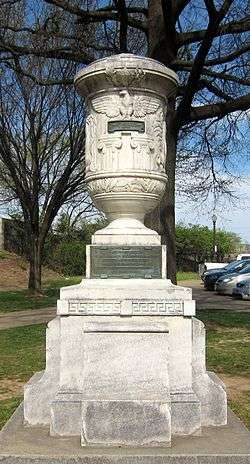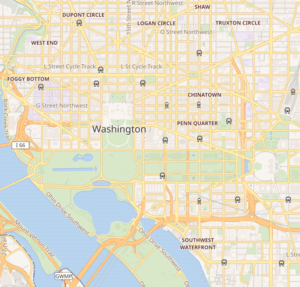Cuban Friendship Urn
The Cuban Friendship Urn, also known as the Cuban–American Friendship Urn or USS Maine Memorial, is a marble statue in Washington, D.C., listed on the National Register of Historic Places.[3] The monument originally stood in Cuba to honor the American deaths aboard the USS Maine during the Spanish–American War in 1898.
Cuban Friendship Urn | |
 | |
   | |
| Location | Washington, D.C. |
|---|---|
| Coordinates | 38°52′42.8″N 77°2′17.7″W |
| MPS | Memorials in Washington, D.C. |
| NRHP reference No. | 07001053[1] |
| Added to NRHP | October 11, 2007[1][2] |
Description
It is located on Ohio Drive, Southwest, Washington, D.C., in East Potomac Park, south of the Tidal Basin near the north end of the 14th Street Bridge.[4] Decorations on the 7-foot (2.1 m) tall urn include an eagle with its wings outstretched and human figures depicted in a neoclassical style.[3][4][5] It once stood atop a column of marble in Havana, to commemorate the U.S. sailors and Marines who lost their lives aboard the USS Maine when it sank in Havana harbor in 1898, and the friendship and bonds between Cuba and the United States.[6] A Spanish inscription on the urn reads in English translation:[6]
The memory of the Maine will last forever through the centuries as will the bonds of friendship between the homeland of Cuba and the homeland of the United States of North America. —Gerardo Machado
History
A hurricane in October 1926 knocked the marble column over where it stood in Cuba, and in 1928 the urn was sent by Cuban President Gerardo Machado to the United States and presented to President Calvin Coolidge.[6]
Some reports say the urn stood for many years outside the Cuban Embassy on 16th Street, N.W., in Washington. After relations between the United States and Cuba deteriorated following Fidel Castro's rise to power in Cuba in 1959, it disappeared from public view.[6] It may have been stolen by "xenophobic vandals .. during the 1962 Cuban Missile Crisis", or it may have been removed for a construction project.[5]
According to the National Park Service, the urn was placed in a West Potomac Park rose garden in 1928, as directed by Congress, near the future location of the Jefferson Memorial, where it remained until the 1940s, when it was moved for the 14th Street Bridge.[7] In 1963, it was said to be in storage.[8]
A 2009 National Park Service publication states that it was discovered in a National Park Service warehouse in 1992 and moved to its present site.[6] However, in 1996, a local alternative newspaper, The Washington City Paper, reported that the urn had recently been found by the Park Service abandoned in Rock Creek Park "lying on its side".[5] The newspaper later reported that the urn was placed in East Potomac Park in 1998 following repair work that cost $11,000.[9]
In 2007, the urn was placed on the National Register of Historic Places.[1]
It has been called one of the "10 monuments you’ve probably never heard of" in the Washington, D.C., region.[10]
References
- "National Register Information System". National Register of Historic Places. National Park Service. July 9, 2010.
- "American Revolution Statuary". National Park Service. 10/11/2007. Retrieved August 10, 2011. Check date values in:
|date=(help) - Cuban Friendship Urn, The Historical Marker Database website, accessed August 14, 2011
- USS Maine Memorial – Cuban American Friendship Urn (ca. 1928), DCMemorials.com website, accessed August 14, 2011
- John Cloud (May 24, 1996). "Have You Seen This Monument?". The Washington City Paper.
- Jaime Boyle, The Cuban-American Friendship Urn, National Mall Times (National Park Service), August 2009.
- Montgomery, David (March 18, 2016). "The last time a U.S. president visited Cuba, we got this friendship urn, which we lost, then found. Symbolic, no?". The Washington Post. Retrieved December 22, 2016.
- Thiry, Paul (1963). "The Washington Plan: Historic Notes". AIA Journal. 39: 95.
(The Cuban Friendship Urn is in storage.)
- "Talkin' Trash". The Washington City Paper. January 30, 1998.
- Clay Risen (July 16, 2007). "Ozymandias's Washington". The Morning News. Retrieved August 13, 2011.
External links
| Wikimedia Commons has media related to Cuban Friendship Urn. |